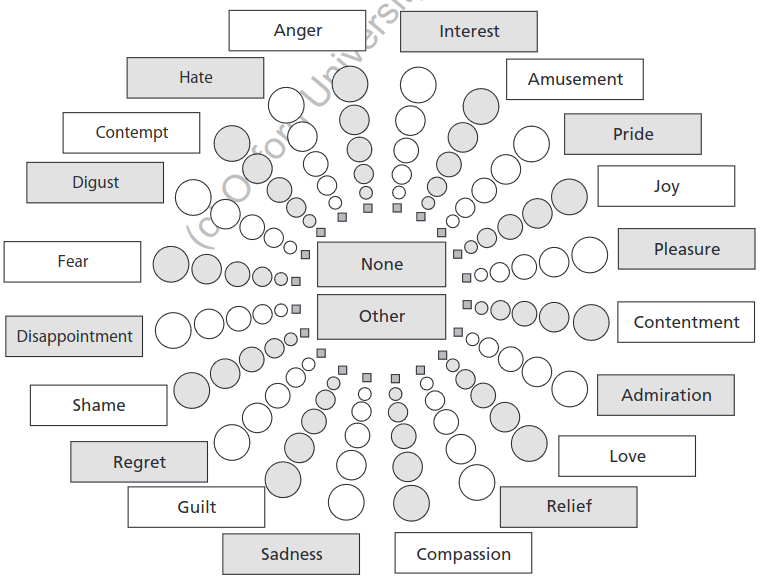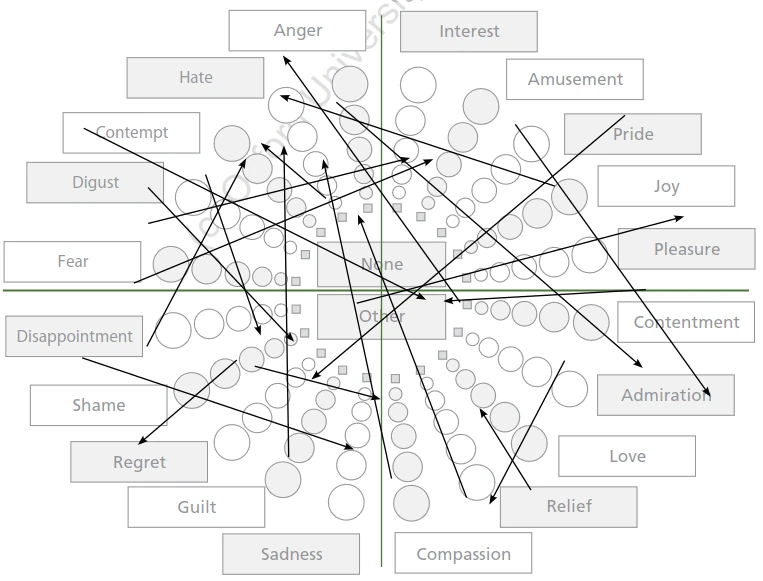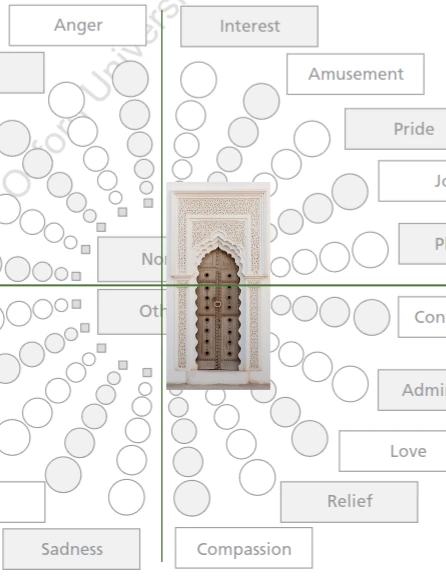Big Emotion #
I’ve often wondered, what is the purpose of my life? Recently, I think a possible answer has come into sharper focus. I have dedicated my life to the search for Big Emotion. This essay is an attempt to convey what I mean by Big Emotion.
Introduction #
Psychologists often ask study participants to describe their feelings. There are two major approaches: (1) discrete emotion labels, and (2) dimensional rating. To help participants respond more accurately, the two approaches can be combined by arranging discrete emotion labels in a two-dimensional affect space. Many researchers have worked on this problem. One way to organize emotions is as follows.
| appraisal dimension | label | axis |
|---|---|---|
| goal conduciveness | valence | x |
| coping potential | control/power | y |

Figure 18.6: Template of Version 3.0 of the GEW as based on the GRID validation.1
Navigation #
To me, the turbulence of life feels somewhat like a random walk on this map. I can pick out at least one memory for many of the random arrows drawn below:

However, some of these emotions are special. The special area of interest has slightly positive valence. I denote it with a door. In the illustration below, this door is centered near the origin and only covers part of the y-axis. However, this is an artifact of my limited artistic ability. The special emotions extend across the y-axis in both the positive (interactive) and negative (effortlessness) directions, hugging the positive side of the x-axis.

Credit: Door imagined by Midjourney
The region of the door is regarded by Internal Family Systems (IFS) as the region of Self Energy. This region might be described with words like compassion, creativity, curiosity, confidence, courage, calm, connectedness, clarity, presence, persistence, perspective, playfulness, and patience. As an IFS client, you learn how to navigate this affect space. You are no longer tossed around haphazardly by your emotions, but you develop a certain degree of Self-leadership. “When the Self is in the lead, the parts provide input to the Self but respect the leadership and ultimate decision making of the Self.”2
Self-Actualization #
I like Maslow’s hierarchy of needs as a way of thinking about fulfillment, that is, what makes life worth living. However, his ideas for the top of the hierarchy, such as self-actualization or transcendence, are too abstract and vague. Maslow didn’t define Self precisely or what it might mean to actualize or transcend it.3 For the top of Maslow’s hierarchy, I suggest Big Emotion because enjoyment is substantially emotional. No longer a frightening, dangerous place, life is now your playground. Despite determinism,4 seize volition. How much can you enjoy yourself (and not just in a hedonistic way)?5 If you are too much in your head (thinking/cognitive) then you cannot enjoy yourself fully. Big Emotion can be found in many areas:
| area | example sub-areas |
|---|---|
| meditation | philosophy, religion, spirituality |
| psychoactive drugs | psychedelics, neuroscience, chemistry, physics |
| diet | gardening, food, biology, toxicology, politics |
| exercise | flow, anatomy, kinesiology |
| sex, relationships, family | developmental psychology, evolution, genetics, urban design |
Often, people have one favorite area, or at most, a few favorites. For example, an important subproblem is how to reconcile psychedelic journeys with our mundane practical reality. I address this subproblem. However, I encourage broader ambition. More enjoyment might be available by exploiting synergies between areas than would be possible when limited to fewer areas. I challenge you to explore and integrate as many areas as possible.
You may like to track your progress using the MEQ30.6 I don’t regard this self-report questionaire as a perfect measure of big emotion, but it’s not a bad proxy.
Notes #
-
Scherer, K. R., Shuman, V., Fontaine, J. R., & Soriano, C. (2013). The GRID meets the Wheel: Assessing emotional feeling via self-report. Components of emotional meaning: A sourcebook, 53, 1689-1699. DOI: 10.1093/acprof:oso/9780199592746.003.0019 ↩︎
-
Sapolsky, R. M. (2023). Determined: A Science of Life without Free Will. Penguin Press. ↩︎
-
Barrett, F. S., Johnson, M. W., & Griffiths, R. R. (2015). Validation of the revised Mystical Experience Questionnaire in experimental sessions with psilocybin. Journal of psychopharmacology (Oxford, England), 29(11), 1182–1190. ↩︎
